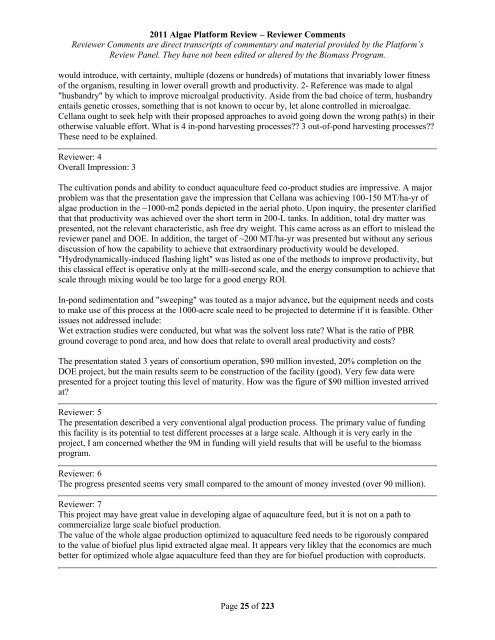Reviewer Comments - EERE
Reviewer Comments - EERE
Reviewer Comments - EERE
You also want an ePaper? Increase the reach of your titles
YUMPU automatically turns print PDFs into web optimized ePapers that Google loves.
2011 Algae Platform Review – <strong>Reviewer</strong> <strong>Comments</strong><br />
<strong>Reviewer</strong> <strong>Comments</strong> are direct transcripts of commentary and material provided by the Platform’s<br />
Review Panel. They have not been edited or altered by the Biomass Program.<br />
would introduce, with certainty, multiple (dozens or hundreds) of mutations that invariably lower fitness<br />
of the organism, resulting in lower overall growth and productivity. 2- Reference was made to algal<br />
"husbandry" by which to improve microalgal productivity. Aside from the bad choice of term, husbandry<br />
entails genetic crosses, something that is not known to occur by, let alone controlled in microalgae.<br />
Cellana ought to seek help with their proposed approaches to avoid going down the wrong path(s) in their<br />
otherwise valuable effort. What is 4 in-pond harvesting processes?? 3 out-of-pond harvesting processes??<br />
These need to be explained.<br />
<strong>Reviewer</strong>: 4<br />
Overall Impression: 3<br />
The cultivation ponds and ability to conduct aquaculture feed co-product studies are impressive. A major<br />
problem was that the presentation gave the impression that Cellana was achieving 100-150 MT/ha-yr of<br />
algae production in the ~1000-m2 ponds depicted in the aerial photo. Upon inquiry, the presenter clarified<br />
that that productivity was achieved over the short term in 200-L tanks. In addition, total dry matter was<br />
presented, not the relevant characteristic, ash free dry weight. This came across as an effort to mislead the<br />
reviewer panel and DOE. In addition, the target of ~200 MT/ha-yr was presented but without any serious<br />
discussion of how the capability to achieve that extraordinary productivity would be developed.<br />
"Hydrodynamically-induced flashing light" was listed as one of the methods to improve productivity, but<br />
this classical effect is operative only at the milli-second scale, and the energy consumption to achieve that<br />
scale through mixing would be too large for a good energy ROI.<br />
In-pond sedimentation and "sweeping" was touted as a major advance, but the equipment needs and costs<br />
to make use of this process at the 1000-acre scale need to be projected to determine if it is feasible. Other<br />
issues not addressed include:<br />
Wet extraction studies were conducted, but what was the solvent loss rate? What is the ratio of PBR<br />
ground coverage to pond area, and how does that relate to overall areal productivity and costs?<br />
The presentation stated 3 years of consortium operation, $90 million invested, 20% completion on the<br />
DOE project, but the main results seem to be construction of the facility (good). Very few data were<br />
presented for a project touting this level of maturity. How was the figure of $90 million invested arrived<br />
at?<br />
<strong>Reviewer</strong>: 5<br />
The presentation described a very conventional algal production process. The primary value of funding<br />
this facility is its potential to test different processes at a large scale. Although it is very early in the<br />
project, I am concerned whether the 9M in funding will yield results that will be useful to the biomass<br />
program.<br />
<strong>Reviewer</strong>: 6<br />
The progress presented seems very small compared to the amount of money invested (over 90 million).<br />
<strong>Reviewer</strong>: 7<br />
This project may have great value in developing algae of aquaculture feed, but it is not on a path to<br />
commercialize large scale biofuel production.<br />
The value of the whole algae production optimized to aquaculture feed needs to be rigorously compared<br />
to the value of biofuel plus lipid extracted algae meal. It appears very likley that the economics are much<br />
better for optimized whole algae aquaculture feed than they are for biofuel production with coproducts.<br />
Page 25 of 223




